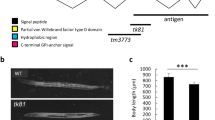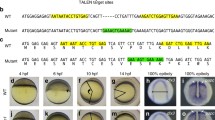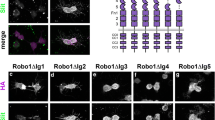Abstract
Repulsive guidance molecule (RGM) a is a glycosylphosphatidylinositol (GPI)-anchored plasma membrane protein that has been implicated in chemorepulsive axon guidance. Although RGMa binds the transmembrane receptor Neogenin, the developmental events controlled by the RGMa-Neogenin interactions in vivo remain largely unknown. We have cloned full-length RGMa from Xenopus borealis for the first time and identified two homologous genes referred to as RGMa1 and RGMa2. Here we show RGMa1 overexpression at 2-cell-stage resulted in cell death, which lead to an early embryonic lethal phenotype of the embryos. Time-lapse photomicroscopy revealed that embryos began to show initial morphological defects from ∼5 h post-fertilization (hpf) which was then followed by extensive blastomere cell death at ∼11 hpf. This phenotype was rescued by simultaneous knock down of RGMa using translation blocking anti-sense morpholinos. Knock down of the RGMa1 receptor Neogenin in RGMa1 overexpressing embryos was also able to rescue the phenotype. Together these results indicated that RGMa1 was signalling through Neogenin to induce cell death in the early embryo. While previous studies have suggested that Neogenin is a dependence receptor that induces cell death in the absence of RGM, we have instead shown that Neogenin-RGM interactions induce cell death in the early embryo. The roles of RGMa1 and Neogenin appear to be context specific so that their co-ordinated and regulated expressions are essential for normal development of the vertebrate embryo.




Similar content being viewed by others
References
Babitt JL, Zhang Y, Samad TA et al (2005) Repulsive guidance molecule (RGMa), a DRAGON homologue, is a bone morphogenetic protein co-receptor. J Biol Chem 280(33):29820–29827
Brinks H, Conrad S, Vogt J et al (2004) The repulsive guidance molecule RGMa is involved in the formation of afferent connections in the dentate gyrus. J Neurosci 24(15):3862–3869
Coen L, du Pasquier D, Le Mevel S et al (2001) Xenopus Bcl-X-L selectively protects Rohon-Beard neurons from metamorphic degeneration. Proc Natl Acad Sci USA 98(14):7869–7874
Connor RM, Key B (2002) Expression and role of roundabout-1 in embryonic Xenopus forebrain. Dev Dyn 225(1):22–34
Conrad S, Genth H, Hofmann F et al (2007) Neogenin-RGMa signaling at the growth cone is BMP-independent and involves RhoA, rock and PKC. J Biol Chem 282(22):16423–16433
Doya H, Ito T, Hata K et al (2006) Induction of repulsive guidance molecule in neurons following sciatic nerve injury. J Chem Neuroanat 32(1):74–77
Greenwood J, Gautier J (2005) From oogenesis through gastrulation: developmental regulation of apoptosis. Semin Cell Dev Biol 16(2):215–224
Hata K, Fujitani M, Yasuda Y et al (2006) RGMa inhibition promotes axonal growth and recovery after spinal cord injury. J Cell Biol 173(1):47–58
Hensey C, Gautier J (1997) A developmental timer that regulates apoptosis at the onset of gastrulation. Mech Dev 69(1–2):183–195
Keino-Masu K, Masu M, Hinck L et al (1996) Deleted in Colorectal Cancer (DCC) encodes a netrin receptor. Cell 87(2):175–185
Kerr JFR, Gobe GC, Winterford CM et al (1995) Anatomical methods in cell death. Methods Cell Biol 46:1–27
Matsunaga E, Nakamura H, Chedotal A (2006) Repulsive guidance molecule plays multiple roles in neuronal differentiation and axon guidance. J Neurosci 26(22):6082–6088
Matsunaga E, Tauszig-Delamasure S, Monnier PP et al (2004) RGM and its receptor neogenin regulate neuronal survival. Nat Cell Biol 6(8):749–755
Mawdsley DJ, Cooper HM, Hogan BM et al (2004) The Netrin receptor Neogenin is required for neural tube formation and somitogenesis in zebrafish. Dev Biol 269(1):302–315
Monnier PP, Sierra A, Macchi P et al (2002) RGM is a repulsive guidance molecule for retinal axons. Nature 419(6905):392–395
Niederkofler V, Salie R, Sigrist M et al (2004) Repulsive guidance molecule (RGM) gene function is required for neural tube closure but not retinal topography in the mouse visual system. J Neurosci 24(4):808–818
Nieuwkoop P, Faber J (1956) Normal table of Xenopus laevis. Daudin, Amsterdam
Oldekamp J, Kramer N, Alvarez-Bolado G et al (2004) Expression pattern of the repulsive guidance molecules RGM A, B and C during mouse development. Gene Expr Patterns 4(3):283–288
Rajagopalan S, Deitinghoff L, Davis D et al (2004) Neogenin mediates the action of repulsive guidance molecule. Nat Cell Biol 6(8):756–762
Samad TA, Rebbapragada A, Bell E et al (2005) DRAGON, a bone morphogenetic protein co-receptor. J Biol Chem 280(14):14122–14129
Samad TA, Srinivasan A, Karchewski LA et al (2004) DRAGON: A member of the repulsive guidance molecule-related family of neuronal- and muscle-expressed membrane proteins is regulated by DRG11 and has neuronal adhesive properties. J Neurosci 24(8):2027–2036
Schmidtmer J, Engelkamp D (2004) Isolation and expression pattern of three mouse homologues of chick Rgm. Gene Expr Patterns 4(1):105–110
Schwab JM, Conrad S, Monnier PP et al (2005) Spinal cord injury-induced lesional expression of the repulsive guidance molecule (RGM). Eur J Neurosci 21(6):1569–1576
Shimuta K, Nakajo N, Uto K et al (2002) Chk1 is activated transiently and targets Cdc25A for degradation at the Xenopus midblastula transition. EMBO J 21(14):3694–3703
Takayama E, Higo T, Kai M et al (2004) Involvement of caspase-9 in execution of the maternal program of apoptosis in Xenopus late blastulae overexpressed with S-adenosylmethionine decarboxylase. Biochem Biophys Res Commun 325(4):1367–1375
Vielmetter J, Kayyem JF, Roman JM et al (1994) Neogenin, an avian cell-surface protein expressed during terminal neuronal differentiation, is closely-related to the human tumor-suppressor molecule deleted in colorectal-cancer. J Cell Biol 127(6 Pt 2):2009–2020
Wilson NH, Key B (2006) Neogenin interacts with RGMa and Netrin-1 to guide axons within the embryonic vertebrate forebrain. Dev Biol 296(2):485–498
Wilson NH, Key B (2007) Neogenin: one receptor, many functions. Int J Biochem Cell Biol 39(5):874–878
Xia Y, Yu PB, Sidis Y et al (2007) Repulsive guidance molecule (RGMa) alters utilization of bone morphogenetic protein (BMP) type II receptors by BMP2 and BMP4. J Biol Chem 282(25):18129–18140
Acknowledgements
This work was supported by NHMRC grants to Brian Key. The authors would like to thank Kathleen Ensbey for assistance with the maintenance of the Xenopus colony at the University of Queensland.
Author information
Authors and Affiliations
Corresponding author
Rights and permissions
About this article
Cite this article
Shin, G.J., Wilson, N.H. Overexpression of repulsive guidance molecule (RGM) a induces cell death through Neogenin in early vertebrate development. J Mol Hist 39, 105–113 (2008). https://doi.org/10.1007/s10735-007-9138-x
Received:
Accepted:
Published:
Issue Date:
DOI: https://doi.org/10.1007/s10735-007-9138-x




